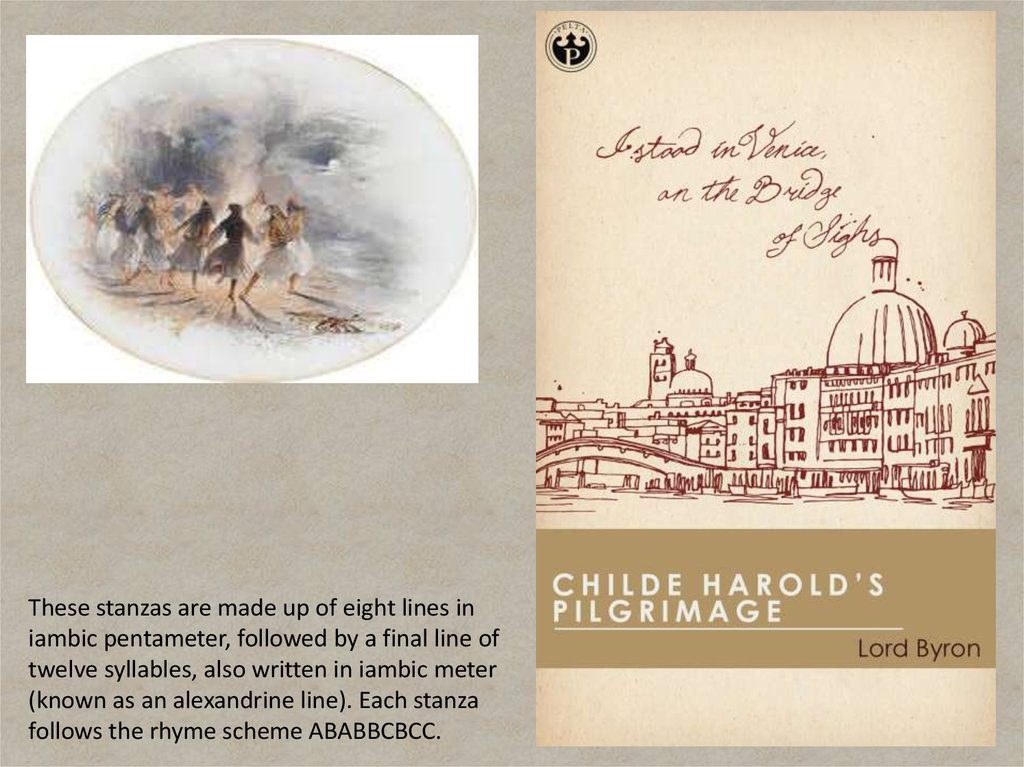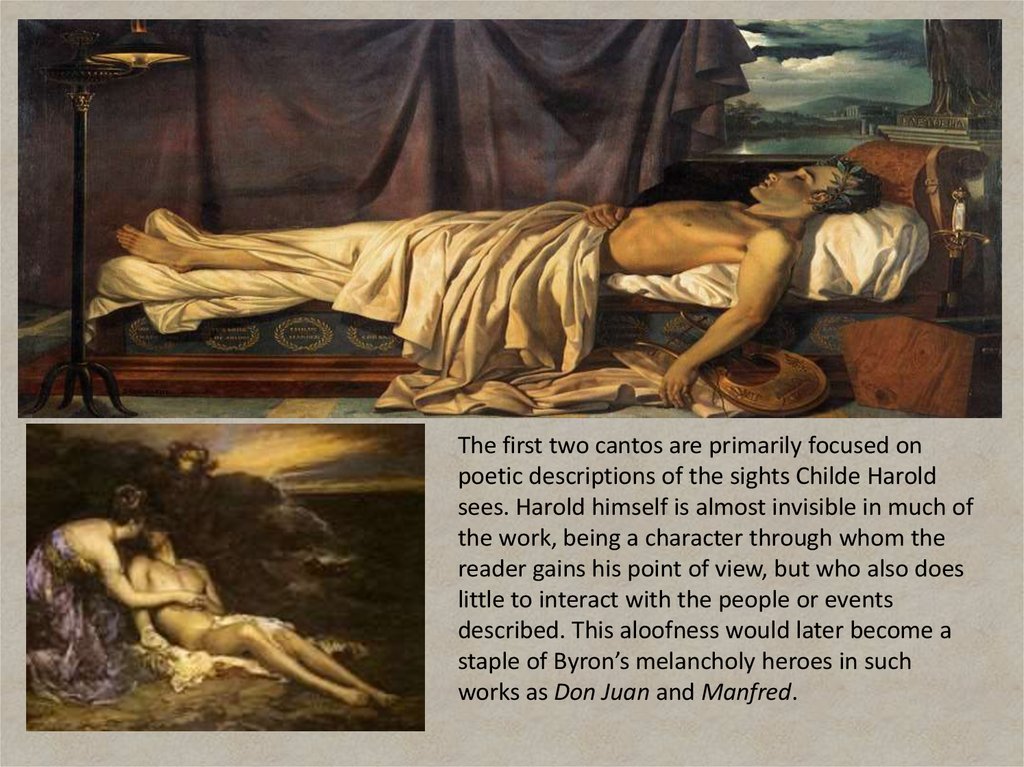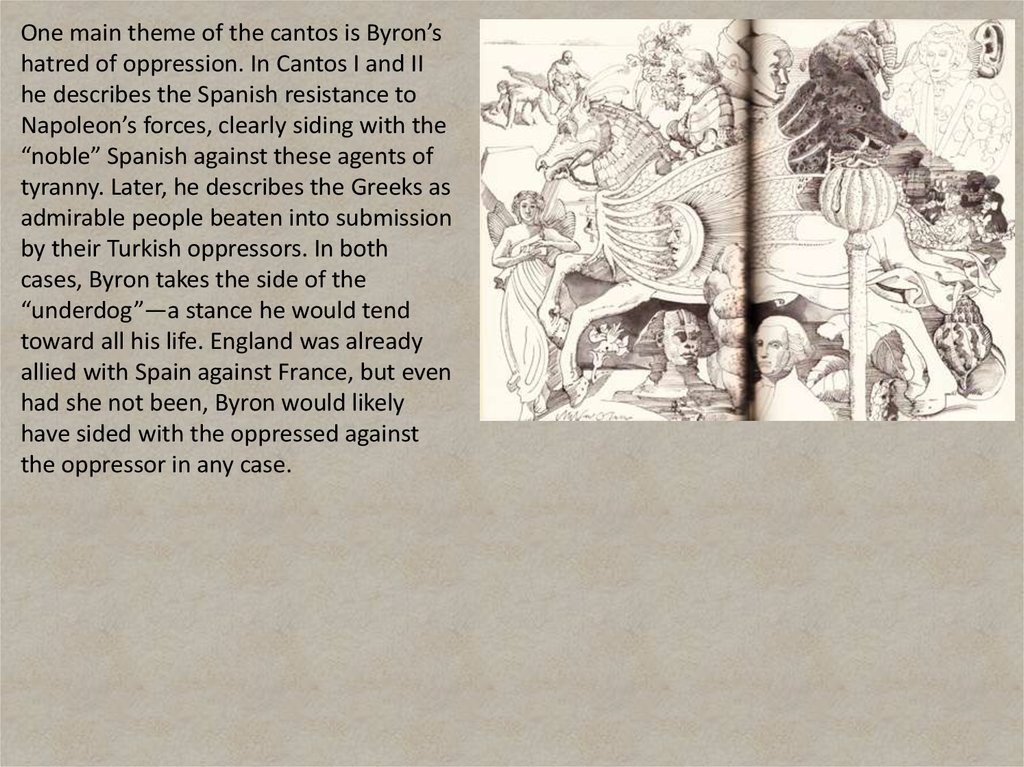Похожие презентации:
Childe Harold’s Pilgrimage
1. Childe Harold’s Pilgrimage
2.
Childe Harold's Pilgrimage is alengthy narrative poem in four parts written
by Lord Byron. It was published between 1812
and 1818 and is dedicated to "Ianthe". The
poem describes the travels and reflections of
a world-weary young man who, disillusioned
with a life of pleasure and revelry, looks for
distraction in foreign lands. In a wider sense, it
is an expression of the melancholy and
disillusionment felt by a generation weary of
the wars of the postRevolutionary and Napoleonic eras. The title
comes from the term childe, a medieval title
for a young man who was a candidate
for knighthood.
3.
The poem contains elements thought to be autobiographical, as Byron generated some ofthe storyline from experience gained during his travels through Portugal,
the Mediterranean and Aegean Sea between 1809 and 1811. The "Ianthe" of the dedication
was the term of endearment he used for Lady Charlotte Harley. Charlotte Bacon née Harley
was the second daughter of 5th Earl of Oxford and Lady Oxford Jane Elizabeth Scott née
Harley, about 11 years old when Childe Harold was first published.
4.
Throughout the poem Byron, in character ofChilde Harold, regretted his wasted early
youth, hence re-evaluating his life choices and
re-designing himself through going on the
pilgrimage, during which he lamented on
various historical events including the Iberian
Peninsular War among others.
5.
Despite Byron's initial hesitation at havingthe first two cantos of the poem published
because he felt it revealed too much of
himself, it was published, at the urging of
friends, by John Murray in 1812, and brought
both the poem and its author to immediate
and unexpected public attention.
6.
Byron later wrote, "I awoke one morning andfound myself famous". The first two cantos in
John Murray's edition were illustrated
by Richard Westall, well-known painter and
illustrator who was then commissioned to
paint portraits of Byron.
7.
The work provided the first exampleof the Byronic hero. The idea of the
Byronic hero is one that consists of
many different characteristics.
The hero must have a rather high
level of intelligence and perception as
well as be able to easily adapt to new
situations and use cunning to his own
gain. It is clear from this description
that this hero is well-educated and by
extension is rather sophisticated in his
style.
8.
Aside from the obvious charm and attractiveness that this automatically creates, hestruggles with his integrity, being prone to mood swings. Generally, the hero has a disrespect
for certain figures of authority, thus creating the image of the Byronic hero as an exile or an
outcast. The hero also has a tendency to be arrogant and cynical, indulging in selfdestructive behaviour which leads to the need to seduce women. Although his sexual
attraction through being mysterious is rather helpful, it often gets the hero into trouble.
Characters with the qualities of the Byronic hero have appeared in novels, films and plays
ever since.
9.
After two years of touring on theContinent Lord Byron wrote the first two
cantos of the poem Childe Harold’s
Pilgrimage. The poem was written at
different periods of Byron’s life. The
hero, Childe Harold, is very often absent
from the poem, and in Canto the Fourth
practically disappears.
10.
Childe Harold came from an old aristocratic family. His ancestors were men of great courageand heroism. Harold’s life was very different from theirs, it is full of pleasure and
entertainment. But now he only felt a great weariness and discontent. He lost faith in
friendship and was disappointed in the world of lies in which he found himself. Hoping to
find Good in other countries he left England. Childe Harold is a sensitive, disillusioned and
generous wanderer.
11.
When the poem first appeared in print, manypeople believed that Byron’s own character was
presented in the person of Childe Harold, but he
author denied it: he justly considered himself to be
an active fighter for freedom, while Harold was
merely a passive onlooker.
Childe Harold leaves his country for Portugal and
Spain; when the ship is far from the shores of
England, he sings Good Night to his Motherland.
12.
Canto the First describesPortugal and Spain. Byron
shows his surprise at the
contrast
between
the
splendour of the land, where
“fruits of fragrance blush on
every tree”, and the poverty
of the people. In the Spanish
scenes the poet shows the
people’s struggle against
Napoleon’s invasion which
the poet witnessed during
the stay in Spain in 1809—
1810. Byron sympathizes
with those people fighting for
their
freedom
and
independence and blames
the ruling classes who betray
the interests of the country.
13.
Canto the Second is devoted to Albania and Greece.Describing Harold’s stay in Albania, Byron depicts his
own adventures in the country. He admires the
Albanians for their kindness, generosity and
hospitality, and praises the great men of the past.
14.
The motif of disappointment sounds with great force when Harold comes to Greece. Themiserable state of the Greek people, who suffer under the yoke of the Turks arouses
Byron’s indignation and makes him recall the glorious past of Greece.
15.
Canto the Third begins and ends with a touchingaddress by Byron to his daughter Ada, whom he
was never destined to see again. From personal
sorrows Byron passes to the sufferings of the
people that groan under the yoke of oppression.
The greater part of canto describes the beautiful
scenery of Switzerland. Pictures of nature — now
calm and serene, now stormy as the feelings of
the poet himself, alternate with philosophical
reflections.
16.
Canto the Fourth, dealing with Italy, is usually regarded as the finest. It describes people andevents of ancient history. Byron regrets the fall of free states, their high culture and art.
Byron calls Italy the “Mother of Art” and admires the Italian people who gave the world such
men as Dante, Petrarch, Boccaccio and other titans of art, science and literature. A great
part of Canto the Fourth is devoted to the theme of genius and immorality. Byron puts forth
the idea that true glory is achieved through creative activity, and not by birth and power.
17.
The merit of Childe Harold’s Pilgrimage is in its broad critical description of contemporarylife and vivid pictures of nature. Byron’s bright characters, beautiful pictures of nature and
brilliant satirical power, rich and melodious verse will be admired by many generations to
come. The poem established Byron as he major literary and romantic figure.
18.
Byron revised and published the first two cantos of Childe Harold’s Pilgrimageduring histravels to Europe in March 1812, and the third and fourth cantos were added later and
published in 1816 and 1818 respectively. Byron envisioned Childe Harold’s Pilgrimage as a
poetic travelogue of his experiences in Portugal, Spain, Greece, and Albania, areas of Europe
not under Napoleon Bonaparte’s direct control. As a record of his journey through lands in
which war was an ever-present specter, it is not surprising that much of the work meditates
upon war, conquest, and violence in the name of one cause or another.
19.
The poem also reflects Byron’s political views, particularly his support for Greekindependence from Turkey (a cause for which he would eventually fight and die) and the very
close-to-home incident of the Convention of Cintra (stanzas 24-26), in which the English
politicians allowed enemy French soldiers captured in battle to return to France with their
loot intact. Besides his politics, Byron also includes his love for the East in his celebration of
the peoples and places he encounters.
20.
The ode “To Ianthe” refers to Lady Charlotte Harley, daughter of Lady Oxford; both womenwere of amorous interest to Byron. Byron added the ode in the 7th edition of Childe Harold’s
Pilgrimage in 1814. In Byron: A Biography, Leslie Marchand writes: "For Byron it was a
delightful situation indeed at the Oxfords': in addition to his charming mistress he had the
companionship of her lovely daughters. They were just at the ages that excited his romantic
sentiments most profoundly. Lady Charlotte Harley, then eleven, was his favourite.
21.
None could have more poignant sentiments ofthe beauty of youthful innocence than the
disillusioned young lord who had known too
early and too well the disappointments of love
fading into satiety. His tribute to the child
exceeded in warmth of idealization anything
he ever wrote of her mother. Nothing could be
more glowing than the five stanzas to this
'Young Peri of the West,' under the name of
Ianthe, which he prefaced to the seventh
edition of Childe Harold (1814)."
22.
Byron intentionally chose to write ChildeHarold’s Pilgrimage in the form of Spenserian
stanzas, a fact to which he draws attention in
the poem’s preface. Each canto is made up of
several nine-line stanzas, each focused on
some aspect of the journey, but with several
linked together by subject.
23.
These stanzas are made up of eight lines iniambic pentameter, followed by a final line of
twelve syllables, also written in iambic meter
(known as an alexandrine line). Each stanza
follows the rhyme scheme ABABBCBCC.
24.
Byron also was self-consciouslyresponding to earlier Romantic
verse, particularly
Wordsworth’s “Lines
Composed a Few Miles above
Tintern Abbey.” Byron engaged
in a kind of love-hate
relationship with Wordsworth
(or at least Wordsworth’s
ideas) in his desire to
simultaneously embrace the
Romantic ideals set down by
Wordsworth and Coleridge in
their Lyrical Ballads, but at the
same time to move beyond
their views on nature as
somehow superior to
humanity and their apparent
narcissism in placing
themselves at the center of
the universe.
25.
Byron also opposed their political views in many areas,particularly in their desire to criticize other nations
without engaging them directly (as Byron did when he
joined the battle for Greek independence).
26.
There are three Classical references to Ianthe,but it is unclear which one (or more) Byron
was alluding to when renaming Lady Charlotte.
The first Ianthe was a Cretan maid betrothed
to Iphis, herself a woman raised as a man.
Because of their love for one another, the
goddess Isis changed Iphis into a man so that
the two could be married. The second Ianthe is
one of the daughters of the titans Oceanus and
Tethyis, making her a sea-nymph. The third
Ianthe is a young woman whom the gods loved
so dearly that they caused purple flowers to
grow around her grave.
27.
The first reference is the most intriguing, asByron spent much of his life until 1814
wrestling with his own sexual identity.
However, the third Ianthe is simplest, since the
real-life Lady Charlotte was only eleven years
old when he met her and thus would invoke
the purity of this maiden beloved of the gods.
The second Ianthe is a nymph, which places
her in the running as a divinity worthy of being
Byron’s muse—and it is fact Ianthe he invokes
as his muse, in true Homeric tradition, prior to
beginning his long narrative of Childe Harold’s
travels.
28.
Тhe first two cantos are primarily focused onpoetic descriptions of the sights Childe Harold
sees. Harold himself is almost invisible in much of
the work, being a character through whom the
reader gains his point of view, but who also does
little to interact with the people or events
described. This aloofness would later become a
staple of Byron’s melancholy heroes in such
works as Don Juan and Manfred.
29.
One main theme of the cantos is Byron’shatred of oppression. In Cantos I and II
he describes the Spanish resistance to
Napoleon’s forces, clearly siding with the
“noble” Spanish against these agents of
tyranny. Later, he describes the Greeks as
admirable people beaten into submission
by their Turkish oppressors. In both
cases, Byron takes the side of the
“underdog”—a stance he would tend
toward all his life. England was already
allied with Spain against France, but even
had she not been, Byron would likely
have sided with the oppressed against
the oppressor in any case.
30.
Indeed, William Flesch notes that “the poem is about the meaning of freedom in all itsforms—personal, political, poetic.” Byron himself felt social oppression and suffering at the
hands of classmates during his school years; later in life he turned this into a general
resistance to oppression. While not always consistent in his personal life, Byron would make
this battle for independence and liberation central to his public persona through his poetry
and political actions.






























 Литература
Литература








